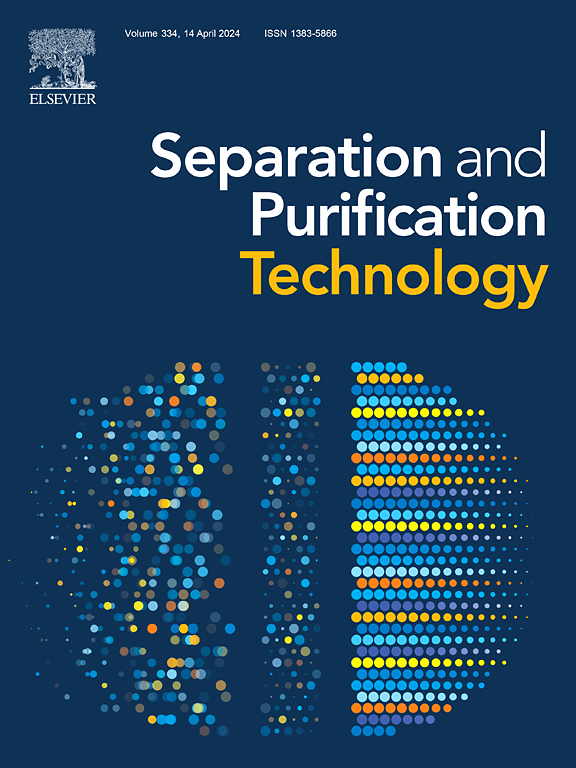Fabrication of CoFe2O4/BC composite for efficient degradation of organic pollutants via percarbonate activation: Performance, mechanistic insight, and toxicity assessment
IF 8.1
1区 工程技术
Q1 ENGINEERING, CHEMICAL
引用次数: 0
Abstract
Advanced oxidation using sodium percarbonate (SPC) is an economical and environmentally friendly method for removing pollutants and treating water bodies. In this study, CoFe2O4 spinel (CF) was loaded onto biochar (BC), as a carrier, to construct a heterogeneous composite catalyst (CoFe2O4/BC). Due to the synergistic interaction between BC and CoFe2O4, CoFe2O4/BC (CFB) effectively and stably activated SPC for removing pollutants from aqueous media. The optimized catalyst (CF/BC = 2:1) CFB-2:1 achieved efficient removal of tetracycline hydrochloride (TC) within 30 min (6.05 and 2.34 times that of BC and pristine CoFe2O4, respectively). The CFB-2:1/SPC system exhibited excellent catalytic performance with variation of the environmental conditions (pH, inorganic anions, humic acids, and water matrices) and good reusability. Quenching experiments and electron paramagnetic resonance (EPR) demonstrated that the degradation of TC in the reaction system involved multiple reactive oxygen species (CO3•−, 1O2, O2•−, and •OH), among which CO3•− and O2•− played important roles. The potential pathways of TC degradation in the system were elucidated via density functional theory (DFT), while the ecological toxicity of the intermediate products was calculated using the T.E.S.T. (Toxicity Estimation Software Tool) method. This work offers novel perspectives on the design of bimetallic catalysts for SPC activation and highlights the potential applicability of this system in remediating of polluted aquatic environments.

CoFe2O4/BC复合材料通过过碳酸盐活化高效降解有机污染物的制备:性能、机理和毒性评估
过碳酸钠(SPC)深度氧化是一种经济环保的去除污染物和处理水体的方法。本研究将CoFe2O4尖晶石(CF)作为载体负载在生物炭(BC)上,构建了CoFe2O4/BC多相复合催化剂。由于BC和CoFe2O4之间的协同作用,CoFe2O4/BC (CFB)有效且稳定地激活SPC去除水中介质中的污染物。优化后的催化剂(CF/BC = 2:1) CFB-2:1在30 min内实现了对盐酸四环素(TC)的高效脱除(分别是BC和原始CoFe2O4的6.05和2.34倍)。CFB-2:1/SPC体系在不同环境条件(pH、无机阴离子、腐殖酸和水基质)下均表现出优异的催化性能和良好的可重复使用性。淬火实验和电子顺磁共振(EPR)结果表明,反应体系中TC的降解涉及多种活性氧(CO3•−、1O2、O2•−和•OH),其中CO3•−和O2•−起重要作用。通过密度泛函理论(DFT)阐明了TC在系统中降解的可能途径,并利用毒性估计软件工具(T.E.S.T.)方法计算了中间产物的生态毒性。这项工作为SPC活化双金属催化剂的设计提供了新的视角,并强调了该系统在污染水生环境修复中的潜在适用性。
本文章由计算机程序翻译,如有差异,请以英文原文为准。
求助全文
约1分钟内获得全文
求助全文
来源期刊

Separation and Purification Technology
工程技术-工程:化工
CiteScore
14.00
自引率
12.80%
发文量
2347
审稿时长
43 days
期刊介绍:
Separation and Purification Technology is a premier journal committed to sharing innovative methods for separation and purification in chemical and environmental engineering, encompassing both homogeneous solutions and heterogeneous mixtures. Our scope includes the separation and/or purification of liquids, vapors, and gases, as well as carbon capture and separation techniques. However, it's important to note that methods solely intended for analytical purposes are not within the scope of the journal. Additionally, disciplines such as soil science, polymer science, and metallurgy fall outside the purview of Separation and Purification Technology. Join us in advancing the field of separation and purification methods for sustainable solutions in chemical and environmental engineering.
 求助内容:
求助内容: 应助结果提醒方式:
应助结果提醒方式:


